Dangers of Flushing Cat Poop Down Your Toilet - Avoid Possible Issues
Dangers of Flushing Cat Poop Down Your Toilet - Avoid Possible Issues
Blog Article
Have you been in search of information and facts around Don’t flush cat feces down the toilet?

Introduction
As feline owners, it's necessary to be mindful of how we deal with our feline buddies' waste. While it may seem hassle-free to purge feline poop down the bathroom, this practice can have detrimental consequences for both the setting and human health.
Ecological Impact
Purging feline poop introduces unsafe microorganisms and parasites right into the water system, positioning a significant danger to aquatic ecological communities. These pollutants can adversely affect aquatic life and compromise water top quality.
Health Risks
In addition to ecological concerns, purging pet cat waste can also posture health dangers to human beings. Cat feces might have Toxoplasma gondii, a parasite that can trigger toxoplasmosis-- a possibly extreme disease, especially for expectant women and people with damaged body immune systems.
Alternatives to Flushing
Fortunately, there are safer and a lot more accountable methods to deal with feline poop. Take into consideration the adhering to options:
1. Scoop and Dispose in Trash
The most usual approach of throwing away pet cat poop is to scoop it into an eco-friendly bag and throw it in the garbage. Make sure to use a specialized litter inside story and throw away the waste immediately.
2. Use Biodegradable Litter
Opt for naturally degradable pet cat clutter made from products such as corn or wheat. These litters are eco-friendly and can be safely dealt with in the trash.
3. Bury in the Yard
If you have a lawn, consider burying feline waste in a marked area far from veggie gardens and water resources. Be sure to dig deep adequate to stop contamination of groundwater.
4. Install a Pet Waste Disposal System
Purchase a pet garbage disposal system specifically designed for feline waste. These systems make use of enzymes to break down the waste, decreasing smell and ecological impact.
Final thought
Responsible family pet possession expands beyond offering food and sanctuary-- it also involves appropriate waste administration. By avoiding purging pet cat poop down the commode and choosing alternate disposal techniques, we can lessen our ecological impact and secure human wellness.
Why Can’t I Flush Cat Poop?
It Spreads a Parasite
Cats are frequently infected with a parasite called toxoplasma gondii. The parasite causes an infection called toxoplasmosis. It is usually harmless to cats. The parasite only uses cat poop as a host for its eggs. Otherwise, the cat’s immune system usually keeps the infection at low enough levels to maintain its own health. But it does not stop the develop of eggs. These eggs are tiny and surprisingly tough. They may survive for a year before they begin to grow. But that’s the problem.
Our wastewater system is not designed to deal with toxoplasmosis eggs. Instead, most eggs will flush from your toilet into sewers and wastewater management plants. After the sewage is treated for many other harmful things in it, it is typically released into local rivers, lakes, or oceans. Here, the toxoplasmosis eggs can find new hosts, including starfish, crabs, otters, and many other wildlife. For many, this is a significant risk to their health. Toxoplasmosis can also end up infecting water sources that are important for agriculture, which means our deer, pigs, and sheep can get infected too.
Is There Risk to Humans?
There can be a risk to human life from flushing cat poop down the toilet. If you do so, the parasites from your cat’s poop can end up in shellfish, game animals, or livestock. If this meat is then served raw or undercooked, the people who eat it can get sick.
In fact, according to the CDC, 40 million people in the United States are infected with toxoplasma gondii. They get it from exposure to infected seafood, or from some kind of cat poop contamination, like drinking from a stream that is contaminated or touching anything that has come into contact with cat poop. That includes just cleaning a cat litter box.
Most people who get infected with these parasites will not develop any symptoms. However, for pregnant women or for those with compromised immune systems, the parasite can cause severe health problems.
How to Handle Cat Poop
The best way to handle cat poop is actually to clean the box more often. The eggs that the parasite sheds will not become active until one to five days after the cat poops. That means that if you clean daily, you’re much less likely to come into direct contact with infectious eggs.
That said, always dispose of cat poop in the garbage and not down the toilet. Wash your hands before and after you clean the litter box, and bring the bag of poop right outside to your garbage bins.
https://trenchlesssolutionsusa.com/why-cant-i-flush-cat-poop/

I am just very fascinated by Can You Flush Cat Poop Down The Toilet? and I hope you liked the blog post. Appreciated our post? Please share it. Help another person discover it. I thank you for reading our article about How to Dispose of Cat Poop and Litter Without Plastic Bags.
Request Estimate Report this page